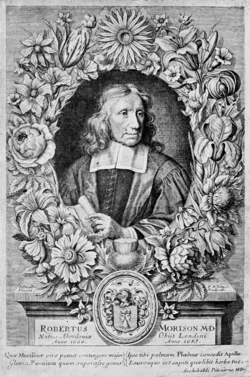Robert Morison facts for kids
Quick facts for kids
Robert Morison
|
|
|---|---|
 |
|
| Born | 1620 Aberdeen, Scotland
|
| Died | 10 November 1683 (aged 63) London, England
|
| Nationality | Scottish |
| Alma mater |
|
| Scientific career | |
| Fields | |
| Institutions | Oxford University |
| Influenced | Carl Linnaeus |
| Author abbrev. (botany) | Morison |
Robert Morison (1620 – 10 November 1683) was a Scottish botanist and taxonomist. He was one of the first people to create a clear system for classifying plants. His work helped future scientists like Carl Linnaeus.
Contents
Biography
Early Life and Education
Robert Morison was born in Aberdeen, Scotland, in 1620. He was a very smart student. He earned his Master of Arts degree from the University of Aberdeen when he was just eighteen years old.
Joining the Cavaliers
During the English Civil War, a big conflict in England, Morison joined the Charles I of England's Cavaliers. These were soldiers who supported King Charles I. He was badly hurt in a battle in 1639. After he got better, he moved to France because the King's side was losing the war.
Studies in France
In 1648, Morison earned a special degree in medicine from the University of Angers in France. From then on, he spent all his time studying plants. He learned a lot from Vespasien Robin, who was the King of France's botanist. Robin introduced Morison to a powerful French duke, Gaston, Duke of Orléans.
Director of Royal Gardens
Because of Robin's recommendation, Morison became the director of the Royal Gardens at Blois, in Central France. He held this important job for ten years, looking after many different plants.
Return to England
In 1660, Morison returned to England. This was after the "Restoration," when King Charles II came back to power. The King made Morison his personal doctor and also his botanist. Morison was put in charge of all the royal gardens. He received a good salary and a free house.
Professor at Oxford University
Years earlier, in 1621, a man named Henry Danvers had given money to Oxford University. This money was for buying land to create a "Physic Garden," which was a garden for growing medicinal plants. He also left money to pay for a professor of botany. In 1669, Robert Morison became the very first professor of botany at Oxford University. He taught there until 1683.
New Ideas on Plant Classification
In 1669, the same year he started teaching at Oxford, Morison published a book called Praeludia Botanica. In this book, he said that plants should be classified based on the structure of their fruits. At that time, most scientists classified plants based on where they grew or what they were used for as medicine. Morison's new ideas were different, and some other botanists did not agree with him.
In 1672, Morison published another important book, Plantarum Umbelliferarum Distributio Nova. In this book, he clearly explained his method for classifying plants. He was the first person to write a detailed study about a specific group of plants, called the Umbelliferae.
His Death
On November 9, 1683, Morison was crossing a street in London. He was accidentally hit by a carriage pole and was badly hurt. He died the next day, November 10, 1683, at his home. He was buried in a church in Westminster.
Works
- Praeludia Botanica (1669): This book included a new edition of a garden catalog and Morison's ideas on plant classification.
- Plantarum Umbelliferarum Distributio Nova, per Tabulas Cognationis et Affinitatis, ex Libra Naturae observata et detecta (1672): This book focused on classifying a specific group of plants.
- Historia Plantarum Universalis Oxoniensis (Vol. 1, 1680): This was a large work about plants, but only the first volume was published during his lifetime.
Legacy
Unfinished Work
When Robert Morison died, his biggest work, Historia Plantarum Universalis Oxoniensis, was not finished. Only the first volume, which described fifteen groups of plants, had been published in 1680. After his death, Oxford University asked Jacob Bobart the Younger to finish the book. Bobart published the second and final part of the Historia in 1699.
Influence on Other Scientists
Robert Morison's work was very important for the study of plants. Even though some people thought he was a bit proud, he helped bring back and improve the way plants were classified. Later, famous botanists like Carl Linnaeus were influenced by Morison's ideas. Linnaeus himself said that Morison helped develop the system of plant classification that was used by others.
See also
 In Spanish: Robert Morison para niños
In Spanish: Robert Morison para niños
Images for kids



